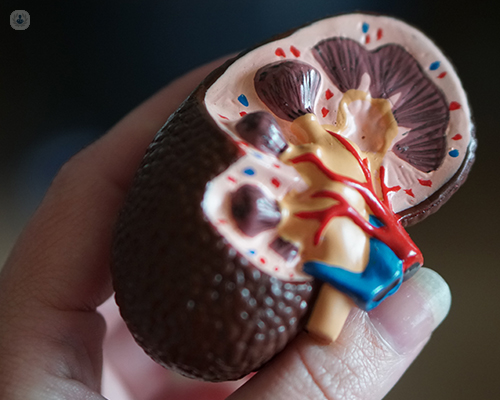Kidney stone removal surgery simplified
Escrito por:Kidney stones are quite common and can have some uncomfortable or painful side effects. If the kidney stone side effects are too much to handle for the patient, surgical procedures may be required. Expert consultant urological surgeon Mr Zafar Maan explains what the procedures are and when they are required in this article.

What are the main types of surgery to remove kidney stones?
There are broadly speaking three different types of treatment for kidney stones. The first is called lithotripsy. This is done in an outpatient setting. It uses sound energy which is focused on to the kidney stone from the outside of the body using an ‘acoustic lens’. The lithotripsy machine produces impulses, known as ‘shocks’, which hit the stone repeatedly causing it to disintegrate. The patient is advised to drink plenty of water so that the fragments and crumbs pass out naturally.
The second type of treatment is called ureterorenoscopy. Under a general anaesthetic, the urologist passes a tiny camera called an endoscope through the urethra (water pipe) and up the tube between the kidney and the bladder, called the ‘ureter’. Any stones that are stuck there can be dealt with, or the scope can be advanced into the hollow space of the kidney where stones typically form. Kidney stones can be disintegrated with a laser into small fragments or scooped up into a basket device and removed with the endoscope.
The third type of treatment is known as ‘percutaneous nephrolithotomy’ which uses a ‘keyhole’ technique to access the kidney through the skin, and place a telescope into the hollow space of the kidney. A variety of energy sources are used to break the stone and remove the pieces. This is very definitive surgery, but needs two or more days in hospital as there is a longer recovery period.
What size of kidney stone requires surgery? Why?
Kidney stones of any size have the potential to increase in size over time and often do. According to evidence-based guidelines, treatment is considered for any stone over four millimetres in size. The main issue is that these stones might move and fall into the ureter causing severe pain or kidney blockage. This condition is called ureteric colic (or ‘renal colic’) and is very uncomfortable indeed. Your urologist will be able to advise you best as the exact position of the stone, stone type, and any background conditions you might have would influence the decision of whether to treat the stone or simply manage it conservatively.
What is recovery like after having surgery to remove kidney stones?
Fast recovery can be expected after lithotripsy; it is done on an outpatient basis. Sometimes patients are given strong painkillers afterwards, so best to have someone else drive you home. Endoscopic surgery, such as ureteroscopy, is usually day case surgery, although occasionally your surgeon may want to keep you in hospital overnight. Often the surgeon will place a ureteric stent, which is a plastic device to drain the kidney down to the bladder internally. Whilst some patients don’t even realise one has been placed, others can experience unpleasant stent symptoms, such as feeling of needing to urinate (even though the bladder is empty). Thankfully, the stent is only a temporary measure to protect the ureter after surgery, and is often removed within a week of surgery.
The recovery for percutaneous surgery is longer. Initially, you might have a tube through the skin to drain the kidney of urine. This is called a ‘nephrostomy’. This tube only stays in place for a day or two usually. A bladder catheter is usually placed at the time of surgery, but is usually removed the next day. Sometimes a ureteric stent is placed too.
Surgery for kidney stones has been revolutionised by these endoscopic techniques and mini percutaneous techniques which have been adopted by our practice.
If you are experiencing side effects from kidney stones and would like to have a consultation, you can go to Mr Maan’s profile and schedule a visit.


